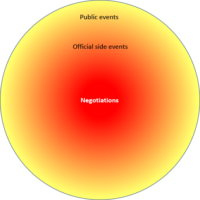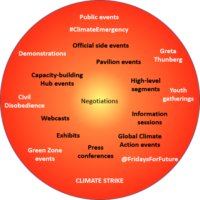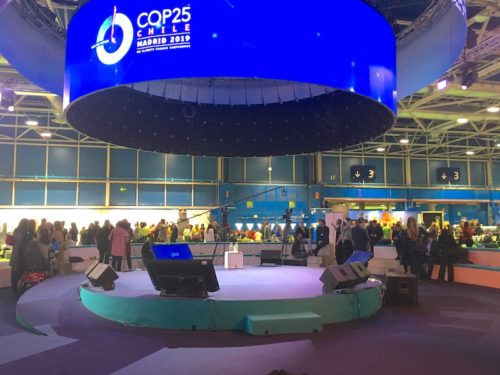Menu
ESI Stories
Impressions from COP25 in Madrid
Contributed by Sarah Meyers
The annual meeting where world governments come together to address the threat of global climate change was not what I thought it would be.
Because the Conference of the Parties (COP) is “the supreme decision-making body”[1] composed of 197 nations that have committed themselves to avoiding climate change, I had imagined that COP25 (the 25th convening of COP) would look something like this:

At the heart of the 2-week summit would be the negotiations. Somewhere there would be a grand hall where all countries were congregated as one and where, theoretically, negotiators could close the doors and say, “we’re not leaving until we come to an agreement.” Here battles would be fought and won. With the media’s and the world’s eyes upon them, the pressure would be tangible. Supporting the negotiations would be official side events, where experts would present their environmental solutions: those ideas, technologies, etc. needed to meet the goals set forth by COP. And finally, public events would provide the energy and inspiration needed to demand more from the negotiators.
In my experience, however, COP25 was more like this, with the sense of momentum and energy reversed:

It was the public and official side events that were the focus of attention and creativity at COP25.
I completely underestimated the sheer volume and complexity of the side events. A sample of happenings drawn from the official calendar, the daily program, and the events overview (each of which had its own, only partly overlapping listings) included high-level segments, Presidency events, special meetings and events, pavilion events, information sessions, press conferences, webcasts, exhibits, Capacity-building Hub events, Action Hub events, and Global Climate Action events. There was a dizzying amount happening at any given moment. It was overwhelming.
Though the public events were not on any official calendar, they were the most real thing happening in Madrid. Youth led the way. They organized through social media and WhatsApp groups, and the rest of the media did their best to keep up. The convention center’s “green zone” (the only area open to the public) was buzzing, with multiple open stages and platforms for anyone and everyone who needed a soapbox. On Friday evening, dozens of indigenous people led 500,000 marchers through the streets of Madrid. They joined Greta Thunberg and @FridayForFuture, who have been striking for the climate every Friday since last autumn.

Demonstrations taking place outside COP25 in Madrid.
It wasn’t until my third day that I noticed that the negotiations were not center stage, either literally or figuratively.
I might have realized this sooner, if I had been able to find where the negotiations were taking place. It took me two days to make my way towards the back of the convention center, where I found dozens of rooms. Here, national delegations would coordinate daily (if not more often) to decide who would go out to discuss what and with whom.[2] And because there were thousands of individual delegates all similarly engaged, negotiations were a complex web of hundreds of interactions each day carried out without knowledge of the outcomes of everyone else’s interactions. I found this beyond mind-boggling. As a policy-making process, does this work? How could it work if negotiations were taking place piecemeal?
Meeting Room 25 was (and would be) the closest I could find to the grand assembly hall I had imagined.[3] I entered the room excited to bear witness, believing that this would be the place for debate, negotiation and conflict mediation at the “meta” level, where the multitude of pieces would be brought together. With all parties present, delegates were having “informal consultations” on Article 6 of the Paris Agreement, a major component of these Climate Talks aimed to jump-start an international cap and trade carbon market. My expectation was that sparks would fly.

The conference floor at COP25 in Madrid.
After two hours, what shocked me most was the lack of sparks. I had expected a lack of intention among the disparate parties; I had not expected the lack of intensity. In the room, there was no energy, no attention, no drive. It’s not that it was boring or dry; rather, it was tired. A sense of urgency was missing. The juxtaposition between the negotiations and the public and official side events was jarring. I tweeted, “The ambiance in Meeting Room 25 is quite different than in the rest of the blue and green zones. If they are like circuses, then this is like watching 1AM public access TV city council planning meeting.”
The saying is, where there’s a will, there’s a way. I left Madrid thinking that there must be a lot more will and way that seeps into the hearts and minds of world leaders. Climate change is the ultimate tragedy-of-the-commons situation that can only be solved through collective action.
I worry that the United Nations, created in the aftermath of WWII, does not have the capacity to solve the climate crisis. And it is here that I see an opportunity for MIT to step up. No, I do not mean that there is some gadget or technology that MIT can create to fix this; I wish it were so simple, but this is not that kind of engineering problem. This is a systems problem, and there are so many people here who light up when presented with these kinds of multi-faceted, messy problems. This kind of complexity is what MIT thrives on. Maybe it’s time for MIT to take on this challenge. Because the politics needed to solve the climate crisis does not exist.
[1] United Nations Climate Change website: https://unfccc.int/process/bodies/supreme-bodies/conference-of-the-parties-cop
[2] Some delegations did not seem to have private meeting rooms, and these groups would publicly convene in a circle on the floor in one of the main halls. Invariably, these delegations seemed to come from countries with fewer resources than other wealthier countries. I was reminded of MIT Sloan Professor John Sterman, who in his C-ROADS climate summit simulations has the team from Developing Countries sit exactly the same way.
[3] There were a number of other enormous spaces (or “plenaries”), but these spaces were intended for staged media events and coordinated presentations.















